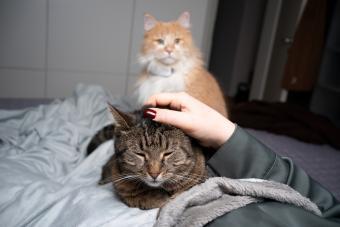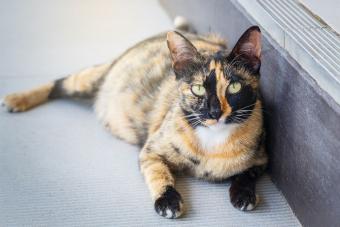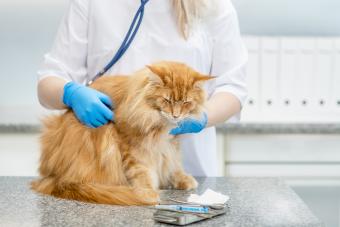
Cats can have vertigo, where they seem to be off balanace and confused, and it's a scary sight to watch. Vertigo in cats - which is known as feline geriatric vestibular syndrome (FGVS) or idiopathic vestibular syndrome - is more common than you think. It affects your cat's sense of balance and can occur in cats of any age.
Even though it can be frightening to see your cat losing balance or falling over to one side, vestibular syndrome usually isn't life-threatening. Learn how to spot the signs and discover medical conditions with similar symptoms, and what you can do to help.
Symptoms of Vestibular Disease in Cats
Vestibular syndrome causes a cat to lose all sense of balance, like severe vertigo in humans. The cause is unknown, although it may be due to changes in the inner ear. It's also possible that inflammation of the nerves in the inner ear leads to the condition. During an episode, your cat will become dizzy and may have additional symptoms.
- Difficulty walking: Cats may fall over to one side or lose balance.
- Abnormal eye movements: Their eyes can uncontrollably dart back and forth.
- Tilted head: Your cat will tilt their head to one side.
- Vocalization: Meows become more urgent and distressed.
- Loss of appetite: They can stop eating because of nausea.
- Stomach problems: You may notice drooling, vomiting, or diarrhea.
- Lethargy: Their energy will be very low and they'll appear weak.
- Seizure-like episodes: Although it's not a true seizure, the combination of symptoms may look like one.
- Facial drooping: The side of your cat's face may droop.
Can vestibular disease kill a cat? No, it's unlikely. The symptoms are really uncomfortable and disorienting, but FGVS itself isn't life-threatening, depending on the root cause.
Difficulty Walking
A cat's movement is affected by FGVS, and this worsens with the progressive stages of the disease. This loss of coordination is also known as ataxia.
- In the beginning stages of FGVS, you will notice your cat "hugging" the walls and moving uncertainly, as if they are off balance.
- As the disease progresses, this can include falling over, running into walls or objects, and walking in circles.
- In the advanced stage, your cat will stagger and stumble, and may be unable to walk at all.
Abnormal Movement of the Eyes
A cat's eyeballs will move about, darting in all directions rapidly. This is known as nystagmus. You may also see your cat's eyes cross, which is called strabismus.
Tilted Head
Cats with FGVS may tilt their head toward the side with the ear that has a lesion. If both ears are affected, then the cat will sway their head from side to side as they move. The head tilt may be accompanied by the cat leaning its entire body to one side.
Vocalization
Your cat may make noises that sound like they are distressed and upset. Their normal meows may change to be much louder and sound more urgent.
Loss of Appetite
Cats with FGVS will have a low appetite. This can be due to nausea as well as the physical difficulty of eating and drinking when they can't properly control their head and body movements. This can eventually lead to weight loss if not treated.
Stomach Problems
Because cats with FGVS are often nauseous, you are likely to see them vomit more often. This stomach upset may also include diarrhea.
It is interesting to note that this disease does not just affect cats. Older dogs also seem to be susceptible, as are rabbits.
Lethargy
Weakness and lethargy are common symptoms of FGVS. Since your cat will have motion sickness and nausea, they'll be less likely to want to get up and move around, and their poor appetite will also lead to weakness. You may also see them hiding more often as they don't feel very well and want to stay in a quiet, low-stress place to feel secure.

Seizure-Like Episodes
Cats with more advanced FGVS may experience episodes that can look similar to seizures. This can happen when the cat has a collection of the common symptoms occurring all at once.
Facial Drooping
You may see drooping on one side of the face with some cats suffering from FGVS. This drooping often occurs because of inflammation in the inner and middle ear on that side of the face, or even worse, a tumor.
These vestibular symptoms could go on for a few days to a few weeks, depending on the individual.
Other Illnesses That Cause the Vertigo and Similar Symptoms in Cats
It is important that you take your cat to the vet immediately if they exhibit any of these symptoms. While vestibular syndrome is not fatal, there are other reasons your cat might exhibit the behaviors listed above. Some other possible causes can be fatal, so it is good to have your pet checked out. Other conditions that may have the same or similar symptoms are:
- Ear infections
- Cancer
- Brain trauma (being hit by a car, etc.)
- Poisoning
- Tumors
- A vitamin B (thiamine) deficiency in your cat's diet
Diagnosing Feline Vestibular Disease
Your vet will do a thorough examination of your cat's ear first, then they'll check their eyes and take blood tests. Imaging tests, such as X-rays or an ultrasound, may be done to rule out tumors if the initial tests are inconclusive. It's not uncommon for a vet to find no definitive reason for the problem.
Treatment for Feline Vestibular Disease
If your veterinarian cannot find a clear cause, they will probably prescribe an antibiotic to address any possible infection that may have been missed in the tests. An anti-fungal may also be included, as well as medications to alleviate the symptoms of nausea and motion sickness.
Prognosis of Feline Vestibular Disease
The problem should begin to clear up in a few days, especially if there is no underlying cause.
- Occasionally, a cat with FGVS will get over it only to be left with a permanent tilt to their head, but this does not seem to keep an affected cat from living a full and comfortable life.
- Typically, a cat that has had an occurrence of the syndrome will not get it again. However, there are some instances where there is a relapse of symptoms, so it can happen.
Tips for Caring for Your Cat During Recovery
While you can't speed up your cat's recovery, there are a few things that you can do to make it easier on you and your cat.
- Keep your cat away from stairs and other areas where they could hurt themselves.
- Keep your pet indoors.
- Follow your vet's instructions exactly.
- Give your cat all of their medication, even if the symptoms end before the medication runs out.
- Since your cat's fine motor nerves are affected, it can be almost impossible for them to eat by themselves without help. You may need to hand-feed your cat and offer water directly to their face.
When to See Your Vet After Treatment Begins
With treatment, your cat should recover from vestibular disease fairly quickly. If they don't, or if any of the following occur, notify your vet:
- Fainting
- Convulsions
- Seizures
- Relapse of symptoms
- Worsening of symptoms
Your Cat Will Probably Overcome Their Vertigo
The symptoms of vestibular syndrome can be frightening, but they usually do not pose a threat to your cat. Stay calm, reassure your pet, and take them to the vet as quickly as possible. An early diagnosis can be especially important if the symptoms are caused by a more serious illness. Stay on top of it, and your cat should make a full recovery.







